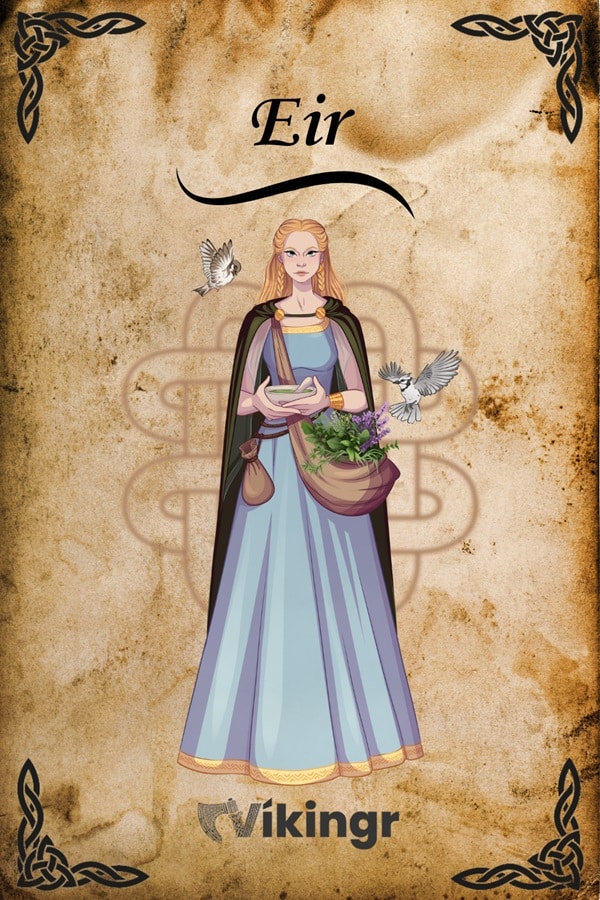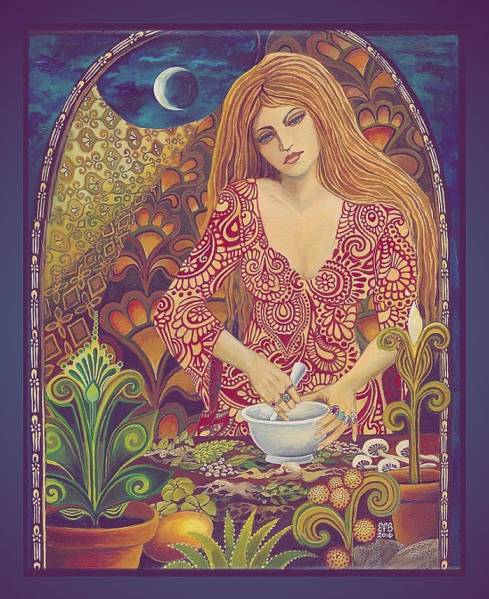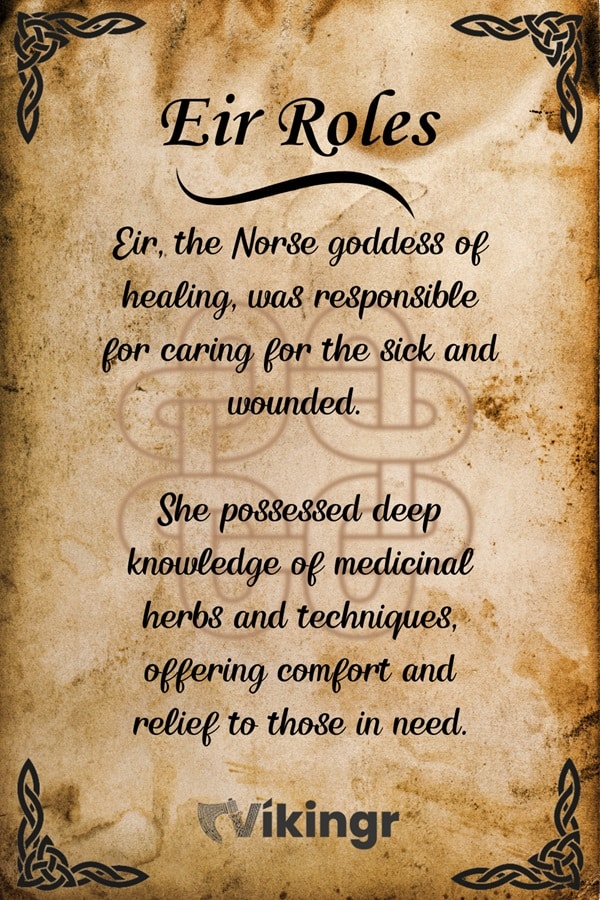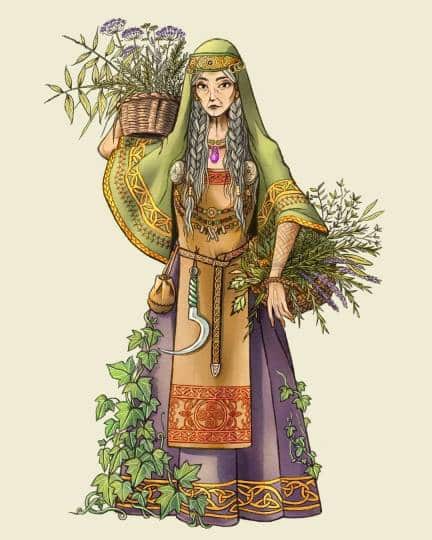Eir was the Aesir goddess of healing, medicin and midwifery. Mystery surrounds Eir as we know little or nothing about her ancestry. However, we know Eir was a popular goddess in the Viking Age. She might have been one of the most invoked for healing and midwifery.
Eir the Healer
References to Eir are scant although quite specific where they do exist. From the Poetic Edda and the Prose Edda to Skaldic poetry and runic inscriptions, there are clues to the existence of this wise and beneficent being.
And yet clues remain to a mystery as yet unraveled. Still, it seems that the mysterious nature of Eir made her somewhat immortalized. Many parents looking for Viking girl name opt for this name, or the variant Eira.

Origins and lineage
Eir is named both as an Aesir goddess, as a Valkyrie, and as an assistant to a jotunn healing deity. This creates some confusion as to her ancestry.
In the first instance, as an Aesir, we know nothing of her heritage.
As a Valkyrie, she might have at one time been human, but again we know nothing of this. As handmaid to a giantess, she may well have some jotunn lineage, but as with her Aesir, or human, we can also not say this for certain.
The powers of the Aesir goddess of healing
As a member of the Ásynjur, Eir is described as being the healer among them. Her role with Menglod at Lyfjaberg, the hill of healing, also confers upon her great powers of medicine and midwifery. As a Valkyrie, she has the gift of healing powers for warriors on the battlefield.
According to some folklore sources, Eir was frequently invoked in healing ceremonies, particularly for the welfare of women and especially with all things related to childbirth.
Modern-day followers of Ásatrú hold Eir in high regard and call upon her for help in all healing and childbirth endeavors.

Mentions and stories from the old texts
The main story involving Eir, although only in passing, is the Fjölsvinnsmál contained within the longer lay of Svipdagr, the Svipdagsmál. The author lists her as one of the helpers of the giantess Menglöð.
Although not a central character in any of the sagas or poems, it is likely that Eir was a popular goddess, particularly among women. Her devotees may have invoked her more frequently for practical purposes more those of the many more famous deities in the pantheon.
Eir in the Poetic Edda
There is no doubt as to her identity by the original composer or composers of the Svipdagsmál or ‘The Lay of Svipdagr’. This later composition of the Poetic Edda holds a clear reference to Eir and a description of her abode.
This lay is composed of two separate manuscripts that were only related to each other in the 19th century. Scholars concluded that the lays known as the Gróagaldr and the Fjölsvinnsmál when put together formed one cohesive whole.
The first part of the Medieval ballad of Ungen Sveidal corresponds to the Gróagaldr while the second match Fjölsvinnsmál. The two stories were considered separate before scholars acknowledged their clear parallel to the sequence of events in Ungen Sveidal. They are now commonly unified under the title of the Svipdagsmál.
In this lay, the hero Svipdagr travels to a mountaintop castle where Fjölsviðr the watchman confronts him. The meeting occurs at the beginning of the Fjölsvinnsmál and the watchman’s challenge leads to a question-and-answer game. During this exchange, Svipdagr learns of the beings who inhabit the castle and their abode.
The mistress of the castle is Menglöð, or Menglod, the giantess. She is a compassionate being who answers the prayers of women in distress. She lives in the company of 9 maidens, each with their own special power. The watchman names all 9, including Eir, whose name distinguishes her as one who offers protection, mercy, and help.
Svipdag spake:
“Now answer me, Fjolsvith, the question I ask,
For now, the truth would I know:
What maidens are they that at Mengloth’s knees
Are sitting so gladly together?”
Fjolsvith spake:
“Hlif is one named, Hlifthrasa another,
Thjothvara call they the third;
Bjort and Bleik, Blith and Frith,
Eir and Aurbotha.
Henry Adams Bellows translation.
The castle is situated on Lyfjaberg, the Hill of Healing. Menglod lives in the hall of Hyrr, ‘The Shining One’. Eir and the other eight maidens live there with her in an enclosure surrounded by fire. This enclosure is called Gastropnir or ‘Guest Crusher’ and was built by Fjölsviðr from the limbs of the giant Leirbrimir.
Eir in the Prose Edda
The classic 13th-century work of the adventurer and scholar Snorri Sturlusson speaks clearly about Eir, although not at great length. Snorri calls her ‘the best of physicians’ and identifies her as an Aesir goddess. His sources for these claims are, unfortunately, not available.

Play Fun Norse Quiz
Is this article making you even more curious about Norse gods and goddesses? You can satisfy your curiosity by playing a fun Norse mythology quiz. This way, you can test your knowledge about Norse gods and goddesses, as well as fill in some gaps. Good luck and have fun playing!
Don’t forget to try our other games as well!
Christian writers, pagan gods

It may be that Snorri placed her into the Aesir tribe because he believed them to be the more wholesome of the two great tribes of the Norse gods. Christian writers often transformed healing goddesses into the Virgin Mary, for example.
Eir is a pre-Christian goddess while Snorri was a Christianized writer of the Icelandic middle ages. It was common practice for Christian writers to alter pagan myths to make them accord with Christian belief.
It is certain however that Snorri had access to sources that are no longer available to us. We must then grudgingly accept the limitations this sets upon our knowledge. Whatever the truth may be Eir, was important enough for him to make two separate references to her in his writings.
Eir in the Gylfaginning
The first of these is in chapter 35 of the Prose Edda in the Gylfaginning. King Gylfi answers questions put to him about the gods in a mysterious palace he finds himself in when attempting to travel to Asgard.
He encounters a being here known as ‘High’, who mentions Eir in a list of 16 Ásynjur goddesses. These were the most important and venerated of the female Aesir deities.
Eir has the distinction of being third on this list and it describes her as ‘an extremely good physician’. Considering the company she is keeping here, the accolade is very high praise indeed.
Eir in the Skáldskaparmál
The second reference comes in chapter 75 of the Skáldskaparmál where the author includes her in a list of Valkyrie. They then conspicuously leave her out of an alternative list of the Ásynjur later in the same chapter.
What then are we to make of these inconsistencies in descriptions of Eir from none less than Snorri Sturlusson himself?
Eir in Skaldic poetry
Skaldic poets frequently reference the mysterious goddess in their poetry and often use her name in kennings for women as a root word combined with another to capture the essential nature of a woman of note.
There are examples of this in the works of 10th-century skaldic poets such as Hallfreðr Vandræðaskáld or Kormákr Ögmundarson. There is also an instance in the famous Gísla outlaw saga.
Eir in the anonymous Þulur
The name of Eir makes an appearance in the thulur mnemonic verses, in another list of Valkyries. Does this make a stronger case for Eir being a Valkyrie rather than a healing goddess? Or perhaps the source material involves more than one female deity with the same name?
Although it may appear incongruous that a healing goddess would be a Valkyrie, in fact, it is not that strange at all. Although we most often associate Odin’s battlefield maidens with death, we can also think of them in terms of rebirth.
They heal the slain heroes they select from the fields of war to live again as Einherjar in Valhalla. They are ‘helper’ deities to Odin and in her aspect as a maiden to the jotunn healer Menglod, Eir also plays the role of assistant. Indeed, one translation of the name ‘Eir’ is ‘helper’.
One name, many goddesses
It is possible then from this point of view to see that Eir of the Valkyrie, Eir of the Ásynjur, and Eir of the Lyfjaberg, Hill of Healing, may all be one and the same. The different names simply represent separate aspects of the same goddess.
Eir in Runic inscriptions
There is at least one significant 12th to 13th-century runic inscription located in Berge, Norway that mentions Eir. It occurs in a kenning of the word ‘woman’ as was often the case in Skaldic poetry.
The rune is inscribed on a stick that records a business transaction but also includes thereafter a short verse, quoted here with the translator’s notes. The anonymous author laments the trouble that women have caused him.
‘Wise Var of wire
[“woman of filigree,” meaning “wise bejeweled woman”]
makes (me) sit unhappy.
Eir [woman] of mackerels’ ground [likely gold]
takes often and much sleep from me.’
Mindy McLeod and Bernard Mees translation.
The authors argue that the first line means ‘women make me miserable’ and the second is that ‘women often take a lot of sleep from me’.
What does all of this have to do with our goddess Eir?
Perhaps not much, except that we know that writers and poets used the name widely, as is seen in later Icelandic metered rímur poetry. We know that they associated it with women, just as Eir herself gave specific help to Norse women in her aspect of handmaiden to Menglod.
Conclusions
This fascinating goddess presents us with more mysteries than conclusions. According to your beliefs or needs, it is equally valid to consider her an Aesir goddess, a jotunn healing deity, a handmaid of Frigga, which may be the true identity of the jotunn Menglod, or as a Valkyrie with healing powers.
The Vikings did not structure their belief as a system of theology. As such, we are free to choose what works best for us at any given time and allow the gods to respond as they see fit.
Frequently Asked Questions
Eir looks after women in labor, protecting both the mother and the infant. She is a deity of protection, keeping all sickness and disease away from those who request her intervention. As a Valkyrie, she brings the souls of great heroes to Valhalla. As a healer is one of the greatest in all the 9 realms.
It is more likely that Eir is an Aesir goddess or a Valkyrie. The Norns are deities responsible for shaping the destinies of all living beings in the 9 realms. There is a tenuous reference to Eir as a Norn, but the evidence is weak.
Depending upon the source Eir is an Aesir goddess, a Valkyrie, or a helper deity to either Frigga or the jotunn healer Menglöð. We can consider her to be all three.
Snorri Sturlusson describes Eir as an Aesir goddess. One source lists her among the Ásynjur, however, this does not automatically make her an Aesir. Sources also list Freya among these most powerful of goddesses but she is a member of the Vanir tribe of gods.
The Valkyries also had healing powers often used on the battlefield. They were also responsible for the rebirth of fallen warriors to their new home in Valhalla.
In all likelihood they frequently invoked Eir to ease childbirth and for everyday healing rituals. Whether they called on her directly or as an aspect of Menglod is hard to say for sure.

Thanks for the article. I’ve been trying to find more information about Eir, and there’s very little out there. I’m fascinated by the representation of her as a Valkyrie who has the courage to choose and guide the slain, but also has the abilities and power to heal. She epitomises the wonder of life and the horror of death.
You are so right! You should check out the “Song of the Spear”, it might be of interest! https://vikingr.org/other-beings/song-of-spear